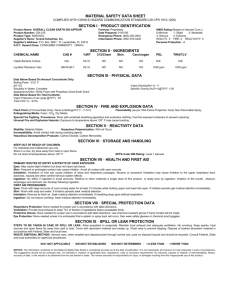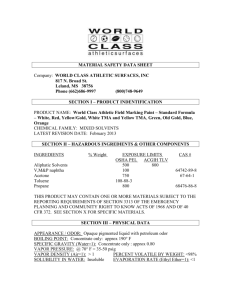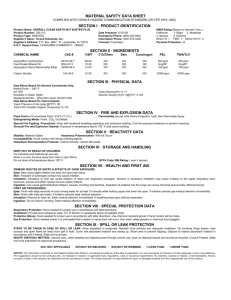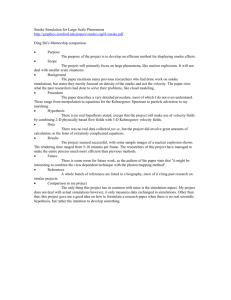Product Safety Data Sheet A120
advertisement
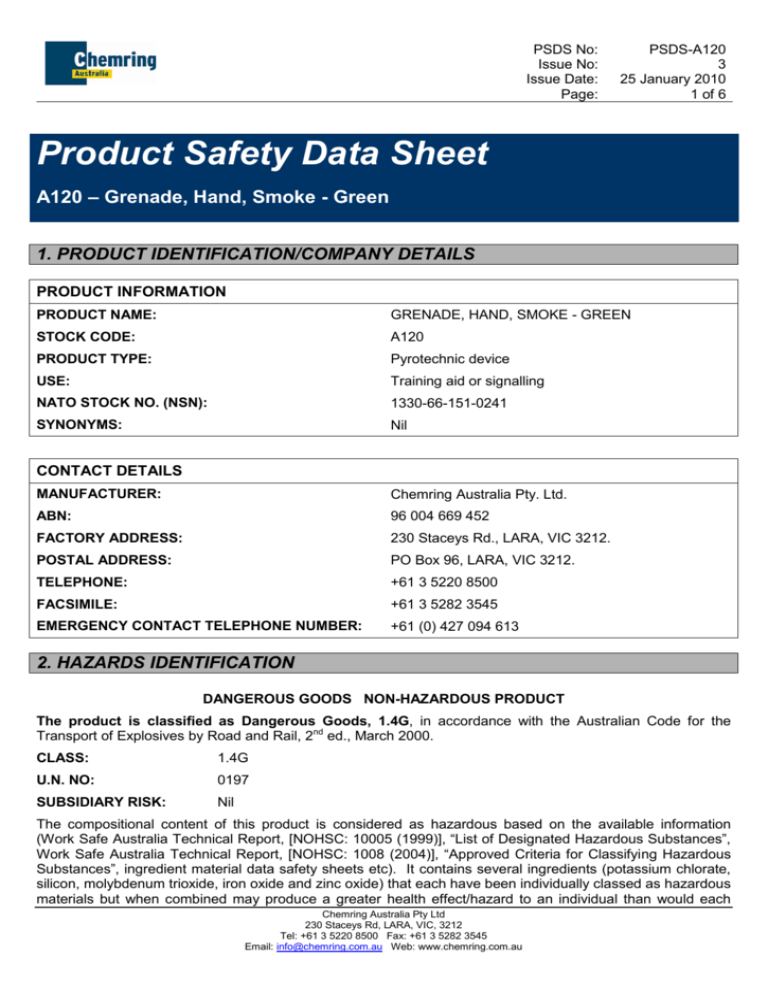
PSDS No: Issue No: Issue Date: Page: PSDS-A120 3 25 January 2010 1 of 6 Product Safety Data Sheet A120 – Grenade, Hand, Smoke - Green 1. PRODUCT IDENTIFICATION/COMPANY DETAILS PRODUCT INFORMATION PRODUCT NAME: GRENADE, HAND, SMOKE - GREEN STOCK CODE: A120 PRODUCT TYPE: Pyrotechnic device USE: Training aid or signalling NATO STOCK NO. (NSN): 1330-66-151-0241 SYNONYMS: Nil CONTACT DETAILS MANUFACTURER: Chemring Australia Pty. Ltd. ABN: 96 004 669 452 FACTORY ADDRESS: 230 Staceys Rd., LARA, VIC 3212. POSTAL ADDRESS: PO Box 96, LARA, VIC 3212. TELEPHONE: +61 3 5220 8500 FACSIMILE: +61 3 5282 3545 EMERGENCY CONTACT TELEPHONE NUMBER: +61 (0) 427 094 613 2. HAZARDS IDENTIFICATION DANGEROUS GOODS NON-HAZARDOUS PRODUCT The product is classified as Dangerous Goods, 1.4G, in accordance with the Australian Code for the Transport of Explosives by Road and Rail, 2nd ed., March 2000. CLASS: 1.4G U.N. NO: 0197 SUBSIDIARY RISK: Nil The compositional content of this product is considered as hazardous based on the available information (Work Safe Australia Technical Report, [NOHSC: 10005 (1999)], “List of Designated Hazardous Substances”, Work Safe Australia Technical Report, [NOHSC: 1008 (2004)], “Approved Criteria for Classifying Hazardous Substances”, ingredient material data safety sheets etc). It contains several ingredients (potassium chlorate, silicon, molybdenum trioxide, iron oxide and zinc oxide) that each have been individually classed as hazardous materials but when combined may produce a greater health effect/hazard to an individual than would each Chemring Australia Pty Ltd 230 Staceys Rd, LARA, VIC, 3212 Tel: +61 3 5220 8500 Fax: +61 3 5282 3545 Email: info@chemring.com.au Web: www.chemring.com.au PSDS No: Issue No: Issue Date: Page: PSDS-A120 3 25 January 2010 2 of 6 separate ingredient. However, as this material is contained within an enclosed canister overall the product is considered as non-hazardous. When fired the product produces an aerosol containing a range of products (green and yellow dyes, boron oxide, fumed silica, potassium hydroxide and metallic molybdenum and iron), several are predicted to be hazardous based on the criteria set down in the Work Safe Australia Technical Report, “Exposure Standards for Atmospheric Contaminants in the Occupational Environment”, NOHSC: 3008 (1995). The aerosol generated should be treated as hazardous as the chronic and acute effects from prolonged exposure to the aerosol are unknown. The recommended exposure limits for some of the combustion products produced are outlined in Section 8: Exposure Controls and Personnel Protection. When fired, a dense green smoke is released which may cause irritation to the eyes and throat. Do not fire this product in confined spaces. The product is designed for outside use only. Risk Phrases Type Explanation R2 Risk of explosion by shock, friction, fire or other sources of ignition. R42/R43 May be irritating to eyes, skin and if swallowed. Safety Phrases Type Explanation S1/2 Keep locked up and out of the reach of children. S16 Keep away from ignition sources – No smoking. S23 Do not breathe smoke. S24/25 Avoid contact with skin and eyes. S34 Avoid shock and friction stimuli. S41 In case of fire and/or explosion do not breathe fumes. 3.COMPOSITION / INFORMATION ON INGREDIENTS The main ingredients (>10%) are potassium chlorate, kaolin, lactose, a blend of solvent green 3A and solvent yellow 33 dyes. Minor ingredients (<10%) are silicon, potassium nitrate, gunpowder, gum Arabic resin, boron, zinc oxide, iron oxide, molybdenum trioxide and dextrin. 4. FIRST AID MEASURES In the unlikely event of receiving burns from this product, seek medical attention immediately. Exposure to the smoke may cause irritation to the eyes and throat. Move the patient to fresh air. Symptoms that may arise if the product is mishandled are: Exposure Route Exp. Symptoms First Aid Measure Ingestion: Discomfort Give plenty of water to drink but only if conscious. Eye Contact: Irritation Immediately flush the eyes with copious quantities of water. Eyelids to be held open. If irritation persists seek medical advice. Chemring Australia Pty Ltd 230 Staceys Rd, LARA, VIC, 3212 Tel: +61 3 5220 8500 Fax: +61 3 5282 3545 Email: info@chemring.com.au Web: www.chemring.com.au PSDS No: Issue No: Issue Date: Page: Exposure Route Exp. Symptoms PSDS-A120 3 25 January 2010 3 of 6 First Aid Measure Skin Contact: Irritation Wash the exposed area with copious amounts of soap and water. Remove contaminated clothing and wash before reuse. If irritation occurs seek medical advice. Inhalation: Throat irritation, shortness of breath Remove to fresh air. Remove contaminated clothing and loosen remaining clothing. Keep warm. Keep at rest until fully recovered. If irritation persists seek medical assistance. Notes to Physician: People subject to complaints with breathing difficulties e.g., asthmatics, chest infections etc can be adversely affected by contact with the smoke from this product. 5. FIRE FIGHTING MEASURES Specific Hazards: Sensitive to heat. Readily ignited and burns rapidly. Avoid all ignition sources. Fire Fighting Measures: Once the device has ignited the signal will burn until all the composition has been exhausted. Allow to burn out and apply a water mist to surrounding areas to prevent secondary outbreaks. Toxic fumes (carbon monoxide and oxides of nitrogen) may be produced from such reactions. Use self-contained breathing apparatus for fires in enclosed areas. It is recommended that a minimum safety evacuation distance of 100 metres be applied if this product is burning in bulk quantities. 6. ACCIDENTAL RELEASE MEASURES Remove ignition sources. Handle with care. Avoid friction and impact. Sweep up, place in a container and hold for disposal. The spill area can then be washed thoroughly with large quantities of water. Contact Chemring Australia for further advice. 7. HANDLING AND STORAGE Handling The product is an explosive (Class 1) and hence should be handled and stored in accordance with the Explosives Regulations of the relevant Competent Authority. Storage Store in the manufacturer’s recommended packaging in a well-ventilated area away from heat and direct sunlight. Chemring Australia Pty Ltd 230 Staceys Rd, LARA, VIC, 3212 Tel: +61 3 5220 8500 Fax: +61 3 5282 3545 Email: info@chemring.com.au Web: www.chemring.com.au PSDS No: Issue No: Issue Date: Page: PSDS-A120 3 25 January 2010 4 of 6 8. EXPOSURE CONTROLS AND PERSONNEL PROTECTION Exposure Standards Recommended exposure limits for some relevant reaction products associated with this product are below, TWAa STELb Boron oxide 10 mg/m3 None listed Fumed silica 2 mg/m3 None listed Potassium hydroxidec 2 mg/m3 None listed Molybdenum metal 10 mg/m3 None listed Hazardous Substance Iron metal fume 5 mg/m 3 None listed Some potassium chloride may also be emitted as part of the aerosol but there are no exposure standards for KCl. Over 50% of the smoke cloud will contain the green and yellow dyes; there are no exposure standards available for these ingredients. a TWA = Time Weighted Average (NOHSC), b STEL = Short-Term Exposure Limit, c Potassium oxide is assumed to rapidly react with atmospheric moisture and form the hydroxide. Exposure Control Measures It is important to understand the firing instructions before use. This signal is designed for outside operation only. Use only in a well ventilated area. The signal is not to be used in a confined area. Personnel Protection For people who experience frequently and prolonged exposure to the aerosols produced by this signal the following item is advised as a minimum requirement: Respiratory Protection It is recommended that disposable paper masks be worn during the handling of this product. 9. PHYSICAL AND CHEMICAL PROPERTIES The signal consists of a corrosion-resistant aluminium can that contains the consolidated smoke composition. The cover plate contains a percussion primer that is actuated when the lever is released. The signal contains a pyrotechnic delay element (2 seconds duration) that allows for safe functioning. The green smoke produced burns for about 1 minute. The temperature of ignition (T of I) has been measured and determined to be 206°C. 10. STABILITY AND REACTIVITY Stability The device is stable under normal storage conditions. Solubility The device is sealed from water ingress. Reactivity Not applicable. Chemical Incompatibilities The O-ring seal may be attacked by organic solvents. Chemring Australia Pty Ltd 230 Staceys Rd, LARA, VIC, 3212 Tel: +61 3 5220 8500 Fax: +61 3 5282 3545 Email: info@chemring.com.au Web: www.chemring.com.au PSDS No: Issue No: Issue Date: Page: PSDS-A120 3 25 January 2010 5 of 6 11. TOXICOLOGICAL INFORMATION No adverse health effects are expected if the product is handled according to this PSDS. If mishandling occurs, consult first aid measures above. The most likely route of exposure would be by inhalation of the aerosol during burning. It is recommended that any effects from inhalation of the aerosol should be treated as outlined in Section 4: First Aid Measures. In the normal mode of operation, upon ignition the mixture of green and yellow dyes is sublimed and recondenses when released into the atmosphere. Exposure studies from effects of inhalation of these dyes have been largely confined to acute exposure effects with little information published and even less information available on the chronic exposure effects. In addition, during the sublimation process there is known to be some thermal degradation of the dyes (typically up to 10%), resulting in various breakdown products of the dyestuffs. The quantity and composition of those breakdown products are dependent on the conditions at the time and hence are ill-defined. It is thus important that the warning on the side of the signal be observed. In addition to the green smoke aerosol released, there will be carbon dioxide and nitrogen gases and water vapour released. Some carbon monoxide may also be released particularly in confined environments. 12. ECOTOXICITY INFORMATION Spillage of the composition or deposition of the reaction products in the soil or aquatic environment should only represent a short term hazard. In the event of spillage of the pellets from the can, the preferred method of disposal after collection of the bulk material would be to clean up with water. If contamination of the waterways occurred this would be of low level and of short duration. Potassium chlorate is a known biocide. After an ignition, a green smoke aerosol would be expected to be released, whilst potassium chloride, kaolin and oxides of silicon and zinc, metallic molybdenum and iron and carbonaceous residues should be confined in the can. After cooling, the spent casings can be removed for disposal. 13. DISPOSAL CONSIDERATIONS Bulk quantities or damaged signals should be packaged in the proper transport containers and destroyed under controlled conditions in accordance with local regulations. 14. TRANSPORT INFORMATION Classification: 1.4G UN No: 0197 Proper Shipping Name: SIGNAL, SMOKE, GREEN NEQ: 0.263 kg Packaging Instruction 135 for Inner and Outer Packagings (Australian Code for the Transport of Explosives by Road and Rail, 2nd ed, March 2000, Appendix A4). The information is this section can be subject to change because of variations in the interpretation of the Australian Explosives Code between the various relevant State and Federal authorities. Chemring Australia Pty Ltd 230 Staceys Rd, LARA, VIC, 3212 Tel: +61 3 5220 8500 Fax: +61 3 5282 3545 Email: info@chemring.com.au Web: www.chemring.com.au

